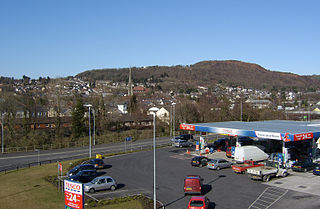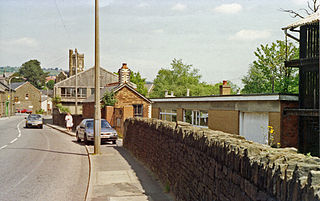Related Research Articles

Until 1974, Glamorgan, or sometimes Glamorganshire, was an administrative county in the south of Wales, and later classed as one of the thirteen historic counties of Wales. Originally an early medieval petty kingdom of varying boundaries known in Welsh as Morgannwg, which was then invaded and taken over by the Normans as the Lordship of Glamorgan. The area that became known as Glamorgan was both a rural, pastoral area, and a conflict point between the Norman lords and the Welsh princes. It was defined by a large concentration of castles.

Ystradgynlais in southwest Powys, Wales. It is located on the River Tawe, and was within the boundaries of the former county of Brecknockshire. The town has a high proportion of Welsh language-speakers. The community includes Cwmtwrch, Abercraf and Cwmgiedd, with a population of 8,092 in the 2011 census; it is the second-largest town in Powys. It forms part of the Swansea Urban Area where the Ystradgynlais subdivision has a population of 10,248.

Pontardawe is a town and a community in the lower Swansea Valley. it had a population of approximately 7,172 in the 2021 Census for Pontardawe Parish, and forms part of the county borough of Neath Port Talbot.

The River Tawe is a 30 miles (48 km) long river in South Wales. Its headwaters flow initially east from its source below Llyn y Fan Fawr south of Moel Feity in the Black Mountains, the westernmost range of the Brecon Beacons National Park, before the river turns south and then southwest to its estuary at Swansea. Its main tributaries are the right bank Upper and Lower Clydach Rivers and the Afon Twrch. The total area of the catchment is some 246 km2 (95 sq mi). The Tawe passes through a number of towns and villages including Ystradgynlais, Ystalyfera, Pontardawe, and Clydach and meets the sea at Swansea Bay below Swansea. The Tawe Valley is more commonly known as the Swansea Valley.

The Swansea Vale Railway (SVR) was a railway line connecting the port of Swansea in South Wales to industries and coalfields along the River Tawe on the northern margin of Swansea, by taking over a tramroad in 1846. It was extended to Brynamman in 1868. Passengers were carried from 1860, and a loop line through Morriston was built.

Bridgend railway station is a main line station serving the town of Bridgend, south Wales. It is located approximately halfway between Cardiff Central and Swansea stations, at the point where the Maesteg Line diverges from the South Wales Main Line; it is also the western terminus of the Vale of Glamorgan Line from Cardiff. It is 190 miles 45 chains (306.7 km) measured from the zero point at London Paddington, via Stroud.
The Swansea Valley is one of the South Wales Valleys. It is the valley from the Brecon Beacons National Park to the sea at Swansea of the River Tawe in Wales. Administration of the area is divided between the City and County of Swansea, Neath Port Talbot County Borough, and Powys. A distinction may be drawn between the Lower Swansea valley and the Upper Swansea valley; the former was more heavily industrialised during the 19th and 20th centuries.
The Llanelly Railway and Dock Company was an early Welsh railway system. It opened its first short line and a wet dock at Llanelly in 1834, and soon went on to build a longer line from Llanelly to serve pits in the Amman Valley, and then on to Llandilo, reached in 1857. The Llanelly company leased and worked the Vale of Towy Railway on to Llandovery, from 1858.
The Vale of Neath Railway (VoNR) was a broad gauge railway company, that built a line from Merthyr Tydfil and Aberdare to Neath, in Wales, mostly to transport the products of the Merthyr iron industries to ports on Swansea Bay.
The South Wales Railway was a main line railway which opened in stages from 1850, connecting the Great Western Railway from Gloucester to South Wales. It was constructed on the broad gauge. An original aspiration was to reach Fishguard to engender an Irish ferry transit and transatlantic trade, but the latter did not materialise for many years, and never became an important sector of the business. Neyland was the western terminus of the line until 1906.
The Dulas Valley Mineral Railway was incorporated in 1862 to bring coal from the Onllwyn area north-east of Neath to the quays there, and in the following year was reconstituted as the Neath and Brecon Railway. The line was opened as far as Onllwyn in 1863.

Upper Bank railway station served the city of Swansea, West Glamorgan, Wales from 1871 to the 1960s on the Swansea Vale Railway.

Brynamman East railway station served the village of Brynamman, in the historical county of Glamorganshire, Wales, from 1868 to 1964 on the Swansea Vale Railway.
Swansea St Thomas railway station served the city of Swansea, West Glamorgan, Wales from 1860 to the 1960s on the Swansea Vale Railway.

Clydach-on-Tawe railway station served the community of Clydach and Ynystawe in Swansea, Wales from 1885 to 1965 on the Swansea Vale Railway.
Glais railway station served the community of Glais in Swansea, Wales from 1885 to 1965 on the Swansea Vale Railway.

Cwmllynfell railway station served the village of Cwmllynfell, in the historical county of Glamorganshire, Wales, from 1896 to 1964 on the Swansea Vale Railway.
Swansea Wind Street railway station served the city of Swansea, in the historical county of Glamorganshire, Wales, from 1863 to 1873 on the Vale of Neath Railway.
Gwys railway station served the village of Upper Cwmtwrch, in the historical county of Brecknockshire, Wales, from 1868 to 1950 on the Swansea Vale Railway.
Morriston East railway station served the community of Morriston, in the historical county of Glamorganshire, Wales, from 1871 to 1950 on the Swansea Vale Railway.
References
| Preceding station | Disused railways | Following station | ||
|---|---|---|---|---|
| Ynysygeinon Line and station closed | Swansea Vale Railway | Cwmtwrch Well Halt Line and station closed |